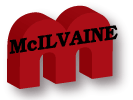
CATER Mask
Decisions
December 10, 2020
Clarification on CDC ASTM
Relationship
Construction Industry is a Long
Term CATER Mask Purchaser
A Guide to Respirators Used for
Dust in Construction Created by
NIOSH
Purar Mask Inward Leakage is
Less Than 2%
China Revised Respirator
Standard on July 1, 2020
SGS Provides Mask Testing
Services
SGS Provides Summary of French
Stipulations for Clear Masks
___________________________________________________________________________
Clarification on CDC ASTM
Relationship
Our article yesterday indicated
that ASTM and CDC are working
together on the mask standard.
This is not a partnership.
It so happens that the
Chair of the ASTM committee
drafting the barrier mask
standard is a senior leader in
NIOSH, a unit of CDC. But
CDC is not allowed
to acknowledge or embrace
the developing standard.
They are aware and have
encouraged their NIOSH
representative to devote full
attention to the standard, but
they have not acknowledged or
recommended the standard.
Construction Industry is a Long
Term CATER Mask Purchaser
After a huge increase in CATER
mask purchases to mitigate COVID
there are many markets where
CATER masks can gain market
share. One of them is
construction. Due to COVID there
is a big demand for CATER masks
in construction. Suppliers have
to explain to the industry why
CATER masks will be the future
choice for low level dust
environments and maybe even for
high dust level environments.
For example supplier personnel
visit construction sites for
periods as short as one hour and
have to wear masks during their
stay. They can have CATER masks
with corporate logos.

The construction industry is
accustomed to masks for COVID.
It is now the time for the
industry to consider CATER masks
for a range of activities. The
difference between COVID and
many construction applications
is that the particulate load is
very high. This makes it logical
to use disposable masks.
However, in most uses the dust
load is moderate. A washable
CATER mask with filter inserts
may be the best. While face
coverings are recommended and
even required on construction
sites across the country,
construction pros have a range
of reasons for not liking them.
According to Construction
Drive they are seen as a
necessary evil, with 67% of
respondents to Construction
Dive's June 12 Friday
Feedback survey saying that they
are an important means of
protection from COVID-19. About
two-thirds of respondents also
said they are required on their
jobsites, either by their firms
or by government protocols.
While construction pros said
they see the need for face
coverings on jobsites, they
don’t always like having to wear
one. Drawbacks include the fact
that they can make the wearer
feel hot and tend to fog
eyeglasses and safety goggles.
Other reasons mentioned were
that they make it hard to
breathe during strenuous
activities, they can fall apart,
and they irritate the skin
behind the ears.
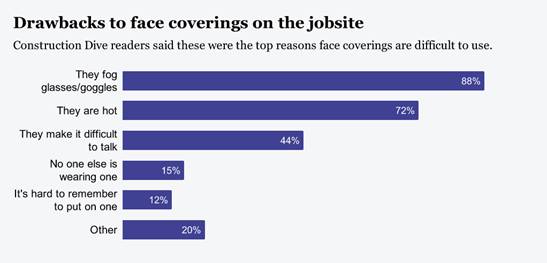
Most construction workers and
site managers are very familiar
with the personal protective
equipment (PPE) that helps
prevent workplace injuries to
the head, eyes, respiratory
system and other vulnerable
areas of the body.
OSHA, the U.S. agency that
mandates the use of PPE on
construction projects and in
other work environments across a
multitude of industries, also
requires employers to train
workers on how to use the
equipment appropriately. The
agency can dish out major fines
if employers don't take this
important step.
So, those in the construction
industry are used to seeing
packaging with instructions
about how to use respirators and
other face coverings, even as
this type of PPE has come into
play in the general population
as people try or protect
themselves from the novel
coronavirus.
The instructions available for 3M's
N95 respirator,
for example, offer a brief,
step-by-step tutorial, complete
with photos, on how to don the
equipment and make sure it's
sealed against the wearer's
skin. The material also comes
with information about which
OSHA standard the respirator
meets and against which
contaminants it protects. The
packaging itself also comes with
instructions.
Not so for other types of fabric
face coverings that contractors
have been buying and wearing as
protection against the
coronavirus. Generally, it's
been a free-for-all as far as
the types of masks available,
whether professionally
manufactured or homemade. The
accompanying advice on how to
wear them and how well they
protect the wearer varies as
well.
But that could be about to
change.
The PPE industry, led by safety
standard organization ASTM
International, is working on a
standard that would specify design
and performance criteria for
reusable masks.
The group, established in July,
aims to set requirements for:
-
The general
construction of
masks.
-
How the mask is
secured to and
stays affixed to
the user's head.
-
How well masks
filter out
bacterial and
solid
particulates.
-
Inhalation and
exhalation
breathing
resistances.
-
Size and fit
testing.
-
Affixing and
removing masks,
sizing, cleaning
and recommended
period of use.
The group is also working to
establish how much of this
information would be displayed
on mask packaging. The standard
would not supplant current mask
requirements for healthcare
workers nor OSHA industry
standards.
A Guide to Respirators Used for
Dust in Construction Created by
NIOSH
This guide cites the advantages
of light filtering facepiece
respirators (FFRs). CATER masks
have many advantages over
disposables. The paragraphs in
red below are particularly
applicable.
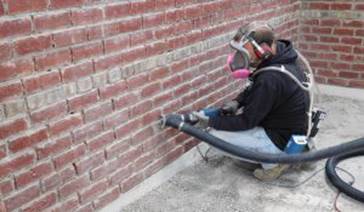
Construction dust can cause
serious damage to workers’
health and life-threatening
diseases. Construction workers
can be exposed to many types of
dust, such as silica, wood, and
lead dust. Workplace exposure to
small particles of silica dust,
also known as respirable
crystalline silica, can lead to
serious diseases, including
silicosis, a progressive lung
disease marked by scarring and
thickening of the lung tissue;
lung cancer; chronic obstructive
pulmonary disease (COPD); and
kidney disease. It’s estimated
that about 2 million
construction workers are exposed
to silica dust on the job [CDC
2020].
NIOSH sets Recommended Exposure
Limits (RELs), including a suggested
limit of
exposure to silica dust. A
recent study of workers exposed
to silica dust by industry
published in the American
Journal of Industrial Medicine found
that of 100,000 workers who were
exposed above the NIOSH REL, 8
out of 10 of those workers were
in the construction industry [Doney
et al. 2020].
Construction workers can be
exposed to silica dust from many
sources. For example, concrete
workers can be exposed to silica
dust during mixing, sawing,
jackhammering, chipping,
grinding, and cleaning
operations. Masons can be
exposed when cutting concrete
blocks and bricks, mixing
mortar, and tuckpointing. Tile
workers can be exposed when
cutting ceramic tiles or stone.
Highway, street, and bridge
construction workers can be
exposed during abrasive
blasting, drilling, milling,
breaking, and cutting concrete.
Site preparation workers can be
exposed during earthmoving,
excavation and trenching, and
demolition, and drywall workers
can be exposed when cutting
drywall and sanding joints.
The Occupational Safety and
Health Administration (OSHA)
silica dust standard for
construction requires employers
to limit worker exposures to
silica dust and protect them [29
CFR 1926.1153]. Table
1 in
29 CFR 1926.1153 has simplified
the compliance process in
construction by matching 18
common construction tasks with
effective dust control methods
and respiratory protection.
Employers who use the controls
specified in Table 1 are in
compliance when they perform
those tasks. If controls are not
being used, or when performing
tasks not listed in Table 1,
employers are required to
conduct air sampling to measure
workers’ exposure to silica or
obtain objective data to
demonstrate that they comply.
In many cases, engineering
controls are not adequate for
safely controlling dust, and
respirators must be used. A
respirator is designed to
protect workers from inhaling
hazardous dusts when properly
used. OSHA regulations govern
the use of respirators in
construction [29
CFR 1926.103].
If respirators are used, a
respiratory protection program
is required to ensure that they
are used properly. OSHA
mandates specific requirements
for the use of respirators [29
CFR 1910.134(c)].
If the workplace is in compliance
with dust standards,
employers can permit workers to
wear air-purifying respirators,
following OSHA’s (Mandatory)
Information for Employees Using
Respirators When not Required
Under Standard [1910.134
App D ].
Under this Appendix, the
employer must meet the following
OSHA requirements:
-
Ensure proper
respirator use
and maintenance
per
manufacturer’s
instructions.
-
Ensure that only
NIOSH-certified
respirators are
used and ones
with the proper
design for the
application.
-
Ensure that the
exposure does
not involve
contaminants
that the
respirator is
not designed to
protect from.
i.e., gases,
vapors, or very
small particles
that the
respirator will
not collect.
-
Keep track of
the respirator
to avoid using
someone else’s.
Selecting the right
air-purifying respirator
requires an assessment of
workplace operations, processes
or environments that may create
a respiratory hazard [NIOSH
2019].
Selecting a Respirator for Dust
Control
The need for light comfortable
NIOSH-approved air-purifying
masks are available in two broad
classes: non-powered and
powered. Non-powered are
sometimes referred to as
negative-pressure respirators,
and powered respirators are
referred to as PAPRs (powered
air-purifying respirators).
Non-powered air-purifying
respirators
Several filter materials are
available for negative-pressure
respirators. Since some filters
are degraded by oil mist,
replaceable filter cartridges
are designated according to
their level of oil resistance,
as follows:
-
N-Series filters
are not
resistant to
oil.
-
R-Series filters
are
oil-Resistant up
to one shift.
-
P-Series filters
are oil-Proof.
For mineral dusts, such as
silica, any of these filters
will work unless the workplaces
has an oil mist source. The most
common oil mist sources in
construction comes from
percussion drills. These
workplaces should use type R or
P filters. If oil mist is
present, N-series filters will
not be effective and should not
be used. R-series filters should
be used for one shift, and
P-series filters should be
changed in accordance with the
manufacturer’s recommendations
[NIOSH 1996].
The dust (or mist) collection
efficiency of filter materials
also varies. Filter cartridges
are available in three
efficiency levels: 95%, 99%, and
99.97%, designated as 95, 99,
and 100. For example, an N95
filter is 95% efficient; an N99
filter is 99% efficient; and an
N100 filter is 99.97% efficient.
The most commonly purchased
filter types are N95s and P100s.
Type 95 filters usually have a
lower cost and breathing
resistance than type 100
filters. As the letter rating
and number rating increase,
breathing fatigue will also
increase.
Reusable half-masks and
face-filtering respirators are
non-powered negative-pressure
respirators.
Reusable Half-Masks
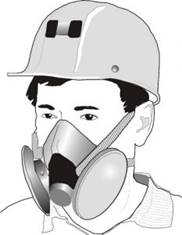
A reusable half-mask,
negative-pressure respirator,
consists of a filter-holding
unit called the facepiece or
mask, fabricated from molded
plastic or rubber. The mask
contains intake and exhaust
valves and is attached to straps
that ensure a tight fit to the
wearer’s face.
This type of half-mask
respirator has a
replaceable-filter that removes
dust when the facepiece seal is
leak-tight. The seal can
occasionally cause skin
irritation. These respirators
also interfere with conversation
and may interfere with
eyeglasses or goggles.
Filtering Facepiece Respirators
(FFRs)

FFRs, commonly called dust masks
are another type of negative
pressure air purifying
respirator. FFRs have a lighter
design than half-mask
respirators. The entire mask
is fabricated from filter
material that covers the mouth
and nose.
FFRs offer some advantages
compared to the
replaceable-filter respirators.
In particular, they are more
comfortable and require no
maintenance. It may be harder to
pass a fit test with an FFR than
a reusable half-mask. As a
result, they are often much less
effective than half-masks.
FFRs are certified by NIOSH
under the 42
CFR 84 respirator
certification tests.
Certification is no guarantee
that the mask will perform well
as worn. In one study of FFRs
[CDC 1998], the average dust
reduction was only 67%.
Powered Air-Purifying
Respirators (PAPRs)
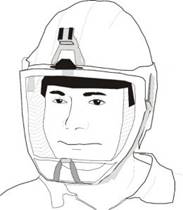
Powered air-purifying
respirators (PAPRs) use a fan to
draw air through the filter to
the user. They are easier to
breathe through than negative
pressure air purifying
respirators; however, they need
a fully charged battery to work
properly. PAPRs have three
filter classes HE, PAPR100-N,
and PAPR100-P. All three filter
series must demonstrate a
minimum efficiency level of
99.97 percent. It is important
to know what the hazard is, and
how much of it is in the air, to
select the proper
filters/cartridges.
PAPRs are often designed with a
hard hat equipped with a
battery-powered fan or a
belt-worn battery and fan,
filtering system, and face
visor, thus providing protection
for the head, lungs, and eyes
and face within one unit.
Another advantage is a lack of
breathing resistance.
Loose-fitting PAPRs have the
ability to accommodate facial
hair. Tight-fitting facepiece
PAPRs are required by OSHA to be
fit-tested and worn without
facial hair.
The NIOSH Certified
Equipment List (CEL)
is a useful resource for making
a respirator selection. The
online CEL tool allows you to
define search criteria based on
characteristics of approved
respirators.
Guidelines for Respirator Use
Respirator wearers should follow
the manufacturer’s instructions.
Comfort is as important as a
tight seal. A worker may need to
try different size respirators
or respirators from different
manufacturers before finding the
best fit for his or her facial
structure. Once a respirator is
put on, positive
and negative pressure seal
checks are
necessary to ensure there are no
leaks that would degrade the
respirator’s effectiveness.
Respirator Maintenance
Basic respirator maintenance is
simple. The wearer should check
to ensure that the filter
cartridges are undamaged, the
inhalation and exhalation valves
are in working order, no straps
are slipping or broken, there
are no tears or deformities in
the facepiece, and the
respirator is reasonably clean.
Regular replacement of filters
is an important part of
respirator use. Normally,
filters should be replaced when
breathing resistance increases
and when they are damaged or
soiled or at the end of the
shift if exposed to oil mists.
Another approach is to replace
filters when the filter loading
reaches 200 mg of dust [NIOSH
2018]. NIOSH has additional
guidance on the reuse and
extended use of filters: Filtering
out Confusion: Frequently Asked
Questions about Respiratory
Protection, Respirator Reuse and
Extended Use.
Many construction tasks can
expose workers to hazardous
dust. Protect your workers by
selecting the appropriate
respirator for the job and
ensure it is used properly
according to the manufacturer’s
instructions and OSHA’s
mandates. Keep your workforce
safe and healthy.
CAPT Alan Echt, DrPH, CIH,
Senior Industrial Hygienist in
the NIOSH Office of Construction
Safety and Health (retired).
Christopher Coffey, Ph.D, is the
former Associate Director for
Science for the NIOSH National
Personal Protective Technology
Laboratory (retired).
Scott Earnest, PhD, PE, CSP, is
the Associate Director for
Construction Safety and Health.
Jeanette Novakovich, MA, MS,
PhD, is a Writer-Editor in the
NIOSH Division of Science
Integration.
CDR Elizabeth Garza, MPH,
CPH, is Assistant Coordinator
for the Construction Sector in
the NIOSH Office of Construction
Safety and Health.
Scott Breloff, Ph.D. is a
Biomedical Research Engineer in
the NOISH Office of Construction
Safety and Health.
Christina Socias-Morales, DrPH,
is a Research Epidemiologist in
the NIOSH Office of Construction
Safety and Health.
Purar Mask Inward Leakage is
Less Than 2%
The description of the M+H Purar
mask was provided in the Alert
yesterday. Here are results of
an inlet leakage fit test
conducted in accordance with the
Chinese Standard which is more
fully described in the next
article.
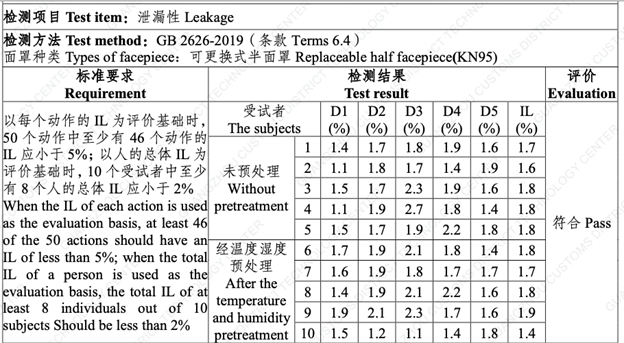
China Revised Respirator
Standard on July 1, 2020
China issued an updated version
of its mandatory national
standard GB 2626-2019
Respiratory protection -
Non-powered air-purifying
particle respirator. A summary
was provided by SGS (see next
article). The revised standard
became effective on July 1,
2020.

The Standardization
Administration of China issued
its mandatory national standard
GB 2626-2019 Respiratory
protection - Non-powered
air-purifying particle
respirator. The new mandatory
national standard will become
effective on July 1, 2020. Being
included in China’s No. 17
announcement on the newly
approved national standards in
2019, this new standard will
replace the previous version, GB
2626-2006.
Scope
This standard applies to
non-powered air-purifying
respirator which can help
provide respiratory protection
against particles. This standard
does not apply to respirator
which provide respiratory
protection against harmful gases
and vapor, and it is not
suitable for the respirators
used in hypoxic environments,
underwater operations, escape
and firefighting.
Technical Requirements
This mandatory national standard
specifies technical requirements
for Respiratory protection -
Non-powered air-purifying
particle respirator, and these
technical requirements include
general requirement, appearance
check, filter efficiency, inward
leakage performance, respiratory
resistance, exhalation valve,
dead space, visual field, head
harness, connection and
connecting parts, lens, air
tightness, flammability,
cleaning and disinfects,
practical performance,
information provided by
manufacturer, and package.
Compared with GB 2626-2006, GB
2626-2019 contains many
technical differences. The
detailed information can be
found in Appendix E in GB
2626-2019.
Classification and Marking
-
Classification
of facepiece
The facepiece shall be
classified according to its
structure, including disposable
facepiece, replaceable half face
piece and full-face piece.
-
Filter element
categorization
The filter element shall be
categorized according to the
filter efficiency, including
Category KN and Category KP.
Category KN is only used to
filter non-oily particles, and
Category KP is used to filter
oily particles and non-oily
particles.
-
Filter element
classification
The filter element shall be
classified according to the
levels of filter efficiency
given in Table 1.
|
CATEGORY OF FILTER ELEMENT |
CLASSIFICATION OF FILTER ELEMENT |
||
|
DISPOSABLE FACEPIECE |
REPLACEABLE HALF-FACE PIECE |
FULL-FACE PIECE |
|
|
Category KN |
KN90 |
KN90 |
KN95 |
|
Category KP |
KP90 |
KP90 |
KP95 |
SGS Provides Mask Testing
Services
SGS is one of the world’s
leading inspection,
verification, testing and
certification company.
It strives to be
recognized as the global
benchmark for quality and
integrity. With more than 89,000
employees, it operates a network
of more than 2,600 offices and
laboratories around the world.
Core services can be divided
into four categories:
-
Inspection: comprehensive
range of
world-leading
inspection and
verification
services, such
as checking the
condition and
weight of traded
goods at
transshipment,
help you to
control quantity
and quality, and
meet all
relevant
regulatory
requirements
across different
regions and
markets
-
Testing:
global network
of testing
facilities,
staffed by
knowledgeable
and experienced
personnel,
enable you to
reduce risks,
shorten time to
market and test
the quality,
safety and
performance of
your products
against relevant
health, safety
and regulatory
standards
-
Certification: we
enable you to
demonstrate that
your products,
processes,
systems or
services are
compliant with
either national
or international
standards and
regulations or
customer defined
standards,
through
certification
-
Verification: we
ensure that
products and
services comply
with global
standards and
local
regulations.
Combining global
coverage with
local knowledge,
unrivalled
experience and
expertise in
virtually every
industry, SGS
covers the
entire supply
chain from raw
materials to
final
consumption.
Established in 1878, SGS
transformed grain trading in
Europe by offering innovative
agricultural inspection
services. The Company was
registered in Geneva as Société
Générale de Surveillance in
1919. Shares were first listed
on (SWX) Swiss Exchange in 1981.
Since 2001, they have only one
class of shares consisting of
registered shares.
From its beginnings in 1878 as a
grain inspection house, it has
steadily grown into the role as
the industry leader. SGS have
done this through continual
improvement and innovation and
through supporting
customers’ operations by
reducing risk and improving
productivity.
SGS adds value from the design
room to the operating room. With
a full-range of services,
including product design
analysis, component and product
testing, auditing, inspection
and retail store checks, SGS
helps businesses deliver
well-designed, functional,
durable and safe products to
their customers. They have the
mask industry, regulatory and
technical expertise required to
check a products’ compliance
against relevant standards
and/or a manufacturer’s own
specifications.
SGS is committed to providing
information about development in
regulations for consumer
products as complimentary
services. Through a global
network of laboratories, SGS
provides a wide range of
services including
physical/mechanical testing,
analytical testing and
consultancy work for technical
and non-technical parameters
applicable to a comprehensive
range of consumer products.
Please do not hesitate to
contact us for further
information.
For more information contact:
Valerie CIMETIERE
Textile Expert
t: +33
(0)6 82 90 18 99
SGS
Provides Summary of French
Stipulations for Clear Masks
Since the early beginnings of
mask development as a new
accessory of daily life, an
issue has been raised as this
face covering hides our mouth
and lips from other people.
More than hiding facial
expression and smiles, hiding
the mouth raises the issue of
lip reading for the deaf or
hearing-impaired, isolating them
more than before.
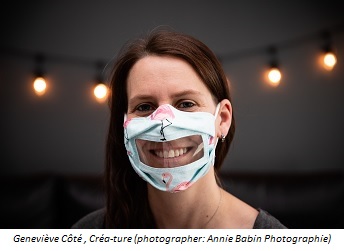
The French authorities have
updated their requirements for
"Community masks" ("Grand
Public") including the option to
include a clear window but
maintaining breathability and
filtration performance when a
piece of transparent plastic
takes the place of textile
fabrics.
The French Cross Ministries Note
has been updated on 2020 July
22nd with specific requirements
for masks with clear window:
-
The impermeable
material must
not exceed 50%
of the mask
surface
-
The impermeable
material must
not exceed 50%
of an 8 cm
diameter circle.
The center of
the circle is
the midpoint
between the nose
and mouth of the
wearer
-
The permeable
material must
make up at least
50% of the mask
surface and must
have an air
permeability
greater than or
equal to 300
L/m2/s
-
The interface
between the
permeable
material and the
impermeable
material must
not leak
-
The impermeable
material should
not be pierced,
to avoid leaks
-
Filtration
efficiency at
3µm for the
permeable
material shall
be the same as
for "Grand
Public" masks
defined in
previous
versions of
Cross Ministries
Note (Annex I):
90% for Cat 1 and 70% for Cat. 2 according to DGA test method -
To avoid leakage
along the edges
of the mask, it
must allow a fit
on the face that
includes the
nose and chin
and the
adjustment at
the mouth must
not create a
retention zone
that can
accumulate
carbon dioxide
-
Washable window
masks must be
able to be
cleaned as other
kinds of
washable masks
except for
ironing (Annex
I)
Available in French only, the
Last version of the Cross
Ministries Note can be found here.
